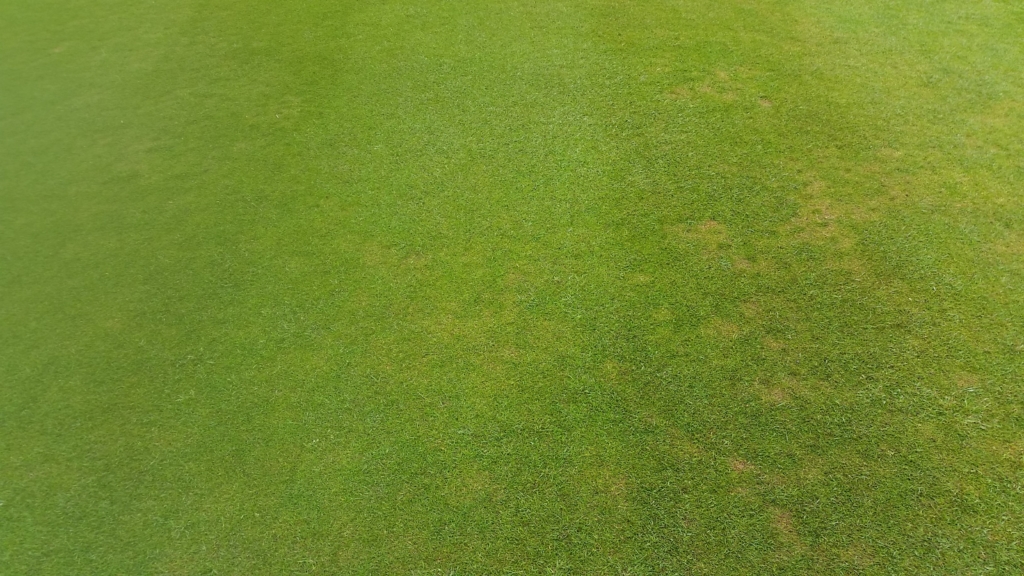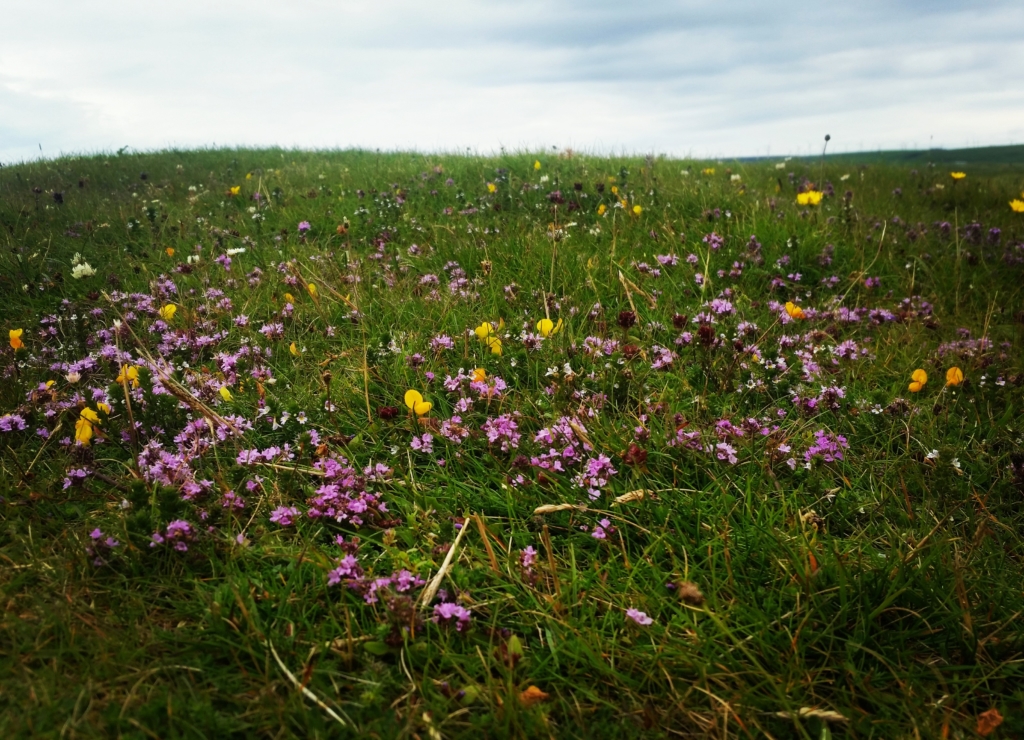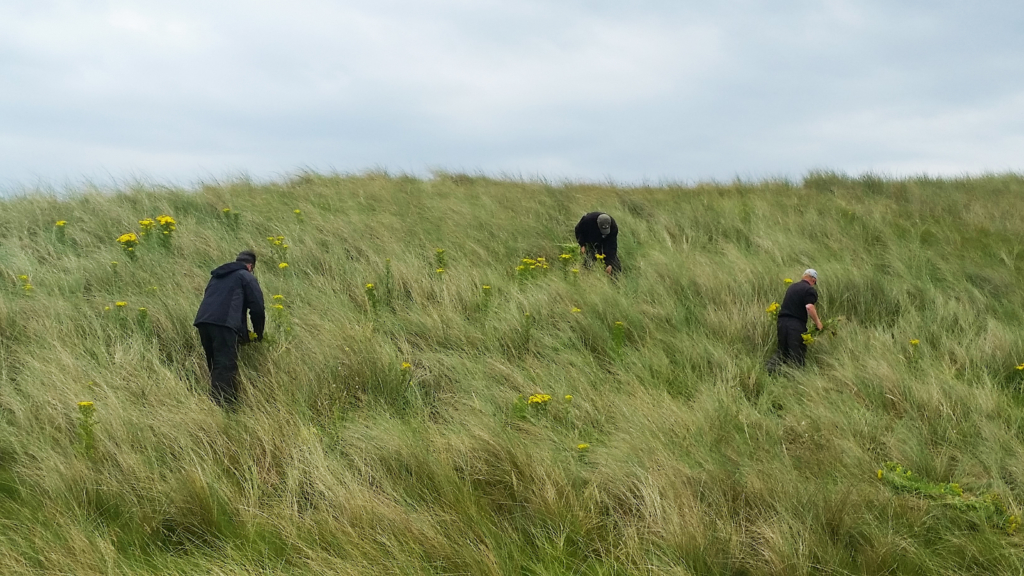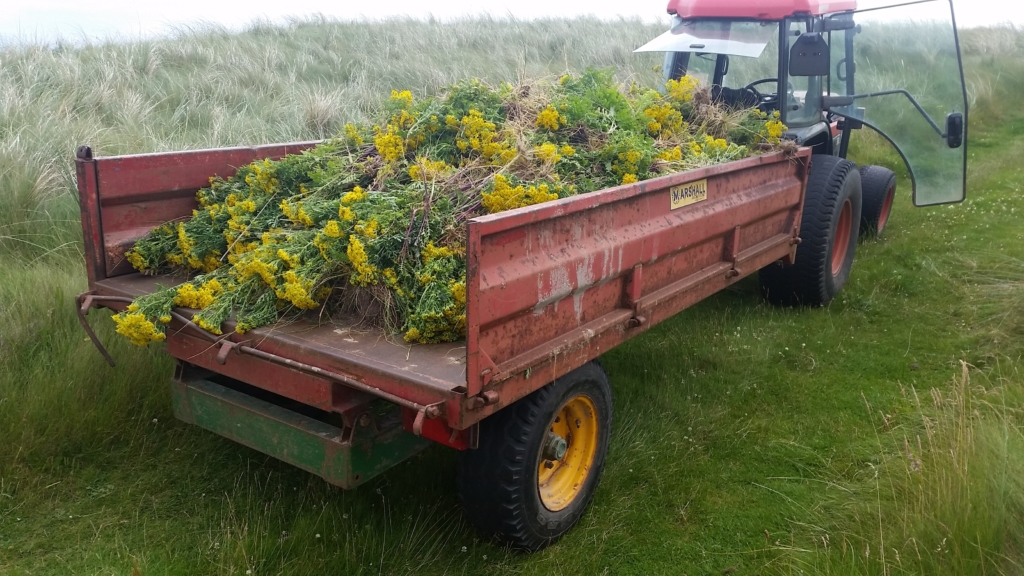…Actually suits us just fine. While everybody else seems to have spent the last few weeks willingly partaking in the Scottish national sport of moaning about the weather, we have been using the mixed conditions we’ve seen lately to recover our surfaces from the wear they suffered earlier in the season.
Although many people seem to be constantly surprised by the cards that the weather gods deal us, it is actually fairly easy to predict and I know from experience that I am usually going to get two spells during the season which are ideal for recovery and to work on plant health and root development. One of those spells tends to fall just after the Campbeltown Open, and this is when we will give the greens a rare Summer feed and overseed them with Bent grass.
Fescue seed can germinate at a temperature as low as 7 degrees C, but Bent insists on more tropical conditions before it can be integrated effectively into the sward. It is important that we do not jump the gun, because Bent seed is horrendously expensive and wasting it by drilling it into a cold rootzone is therefore an absolute sin. We test whether the rootzone is ready by picking on a couple of worn patches, spiking these areas with a fork and overseeding into the holes and then waiting 7-10 days to see if anything pops through. If we get a successful take we immediately haul out the seeder and go hard at it, pumping every grain of seed we have in our store into the greens.
During the period immediately after seeding, it is massively important that the greens are fed sufficiently to provide nutrients for the new seedlings and that the immature plants are not allowed to get anywhere near drying out. This of course goes against our usual links policy of only feeding and watering our greens when we absolutely have to, and because of our desire to bring as many of these plants to full maturity as we can our greens will usually be a bit more green, lush and will putt a little more slowly than they do during the rest of Summer. Obviously we cannot just lower the height of cut to counteract this change in conditions as this would just kill the new grass as soon as it pops through. These are the times when we rely on our friend the ride-on roller to bail us out… if he can polish an extra foot onto the stimpmeter reading then we can get away with relaxing the maintenance pressures a little, giving our precious new seedlings the best chance of long-term survival. As you can see from the picture below, we have seen some good initial results!

When Is A Weed Not A Weed?
At Machrihanish Dunes the answer to that is most of the time, as my definition of a weed is a plant whose presence is undesirable. I remember somebody during my time as greenkeeper at Machrie asking me when I was planning to spray the semi-rough, because it was “full of weeds”. My reply was courteous, but I did wonder how anybody with the gift of eyesight (or indeed a sense of smell!) could seriously suggest that the amazing display of colour in our “machair” rough should be sprayed in order to attain a monoculture of turfgrass!
Here at Machrihanish Dunes, the cut rough is arguably even more spectacular at this time of year than it was in Islay, with daisies, buttercups, yellow and purple vetch, clover, bedstraw, speedwell and many other low-lying plants easily surviving the carefully managed rough mowing regime and providing an incredible display of colour that in my experience has only been matched by a wild meadow I once stumbled across in the French Alps. It is easy to fixate on the many species of orchids that populate the less maintained areas of our rough because they are stunning to look at and are in many cases extremely rare, but there is more to our machair garden than just the protected species and we are extremely lucky that we get the opportunity to appreciate the free flower show every Summer. Even if there were no official restrictions placed on our maintenance regime, there is no way you would ever catch me in there with a crop sprayer!

One plant that is definitely not welcome at Machrihanish Dunes is ragwort! This invasive species causes us a massive maintenance headache every July, and it seems that this year’s crop is an absolute bumper. Because of the negative implications that spraying ragwort would have on other delicate species that we are charged with keeping alive, we have no choice but to pick the yellow peril by hand. This is obviously a very laborious task and is just one of the many jobs that we undertake every year that our members and visitors may not even realise that we do, but if we were to ignore it for even a couple of years the spread of this plant would be catastrophic. Interestingly, our agreed management program with SNH requests that we retain 15% of our crop of ragwort every year because the larvae of the rare cinnabar moth feeds on the flowers, which just goes to reiterate my belief that manipulating nature for our own benefit will always have a negative impact somewhere down the line. I think the moths might be safe enough this year though; there is definitely enough ragwort to go ‘round! All we can do is soldier on a trailer load at a time and see how much we can pull before the flowers dry out and blow in the wind to start growing next year’s crop. At this moment I’m not sure whether my fellow greenkeepers or my own back hates me more!


Decisions, Decisions.
Many of the products that we have used with good effect for decades to control pests and diseases are being refused new licenses by government agencies fearful of the effects of the misuse of chemicals on users, third parties and on the environment. Greenkeepers who have got used to having a full arsenal of these products at their disposal and who have utilised them to produce fantastic surfaces over the past few years are going to find it increasingly difficult (if not impossible) to match those successes in the future without the aid of these chemicals, and the loss of some key products are already causing us major headaches.
Here on the west coast we suffer from very severe infestations of leatherjackets (the larvae of the crane fly or daddy long legs), as our warm, wet Winters provide ideal conditions for them to grow and thrive in sandy, open rootzones through which they find it easy to move around to find the food and air they need to survive. They eat copious amounts of grass roots and organic matter, and will hide in aeration holes and increase the diameter of those holes by coming up to the surface at night and chewing the grass around them at a time of year when there is little growth for the plant to recover from the damage.
Clorpyrifos was our go-to organophosphate insecticide for controlling leatherjacket infestations, and all we had to do in past years was make one or at the very most two well-timed applications per year to control this pest and ensure that our greens were free from attack. It was cheap, easy and extremely effective, but like all organophosphates Clorpyrifos had health implications for the user and a special mask had to be worn when applying it in order to avoid negative respiratory effects, which could quite commonly be felt if appropriate protective equipment was not used as instructed. Like Malathion and many other insecticides before it, Clorpyrifos eventually had its license for use revoked and 2016 was the last year that end users such as ourselves were permitted to use it.
There is usually a proven natural alternative to a chemical in a case such as this, an alternative that might invoke a change in attitude or an alteration to a management regime that would invariably involve more work but would be just as successful, while offering the bonus of being less dangerous for the user and better for the environment. That is how it usually goes anyway! In the case of clorpyrifos, there is no proven natural or chemical alternative that we can switch to and trust to work. To be honest, it has got us all panicking, because we know how incredibly damaging these pests will be this Winter if we do not come up with something that works as well as a chemical insecticide, and quickly.
Currently two options are being promoted—the first of which is a biological product which offers a spray of living nematodes that the manufacturers claim will seek out and kill leatherjackets for food, which in turn will make them strong so they will breed and populate the rootzone so that they are ready for the crane fly to lay more larvae for their next meal. This sounds great, for if these nematodes are successful then surely they will breed and go on populating our rootzone indefinitely, spreading from the greens where they were initially sprayed through the collars, the fairways, the roughs, next door into Machrihanish Golf Club’s fairways and so on, ad finitum. Three things worry me, though, the most obvious of which is the massive scepticism of all the salesmen that I deal with and trust. All have said that they will sell me the product, but they have also all stated that they have no confidence in it and have sold it to golf courses who have seen it completely fail, leaving them with massive infestations and greens and tees in poor condition going into Spring 2016. The second thing that worries me about this product is the lack of positive testimonials.Usually when a new product hits the market and turns out to be a winner the internet is awash with stories about how it has turned golf courses around, but in this case the search engines have come up with depressingly little. The third and most obvious issue that I have with this product is that it is obvious to me that the nematode in question is not currently present in our rootzones. Why is this? Surely if we have massive annual leatherjacket infestations, and nature invariably has its way of maintaining an equilibrium when dealing with these matters, then we should expect these nematodes to be plentiful in our soils. Clearly that is not the case, though, as for years we have had to resort to using Clorpyrifos in order to do their job for them! Could our rootzones be too dry for them to survive? Could high salt levels be a terminal issue for them? Or have we been unwittingly using another chemical (possibly Clorpyrifos itself!) as part of our greens management and unknowingly killing them? Or (and this is my favourite theory) is there another organism that flourishes in the conditions on our site that kills nematodes? Wouldn’t that just be typical, if we sprayed an organism into our rootzone with the intention of controlling another organism that we considered to be undesirable, only to find that the beneficial organism was killed by an indigenous foe first! I’m only theorising here because this product is so new that I don’t have any facts to help me, which is why I and many other people in the industry remain sceptical in the face of the absolute carnage that would be the result of failure. There is a chance that the product might work brilliantly for us, but I for one do not want to have to rely on a third party that I cannot even see to do a job for me when the result of it not doing that job is that our greens would sustain severe damage and would perform poorly until at least the middle of the season!
The second product seems more promising, because it consists of a natural garlic-based granule that is applied at the time the adult crane fly lays its eggs and is brushed down aeration holes during a period when we would all be aerating anyway as part of our Autumn renovation program. The poly-sulphides in the garlic apparently kill the eggs and indeed very young larvae, halting the infestation before it even starts. In effect, the garlic product is used as a direct replacement for Clorpyrifos, and is surely then the answer that we are looking for! Or is it? The problem with this product is that it is very new, and is just as unproven on our site as the nematodes are. To make matters worse, we used a spray version of this product last year and it had no effect whatsoever on leatherjacket populations. A greenkeeper who works in very close proximity to me used the spray at least twice and also reported that it had little or no effect on his leatherjacket infestation. The manufacturers of this product are adamant that the granule version will work if it is applied at the right time of year and is integrated properly into the rootzone and have said that in hindsight, spraying liquid garlic onto the surface in an attempt to kill larvae that had already reached a point of maturity was never going to do us much good. It is encouraging to see that they have been successful in gaining a license from the government that states the product can be used for leatherjacket and chafer grub control. That would seem to indicate that the government body who issued the licence has done a study and has confidence that it will do the job, and if that is the case then it would seem to be by far the safer of our two options.
I can hear one or two of you murmuring in the background already, and of course what you are saying seems so obvious…if leatherjackets are such a serious issue for us then why do I not use both products because that would double my chances of success? Well the fact is we can’t, because the poly-sulphides in the garlic definitely kill nematodes. That is what the garlic product was originally packaged for, to kill a different breed of nematodes that negatively affect the health of ryegrass in football pitches, and apparently it does a very good job of it. You honestly couldn’t make it up, could you! It leaves me with a straight choice between something that I have very little confidence in and something else that I have very little confidence in, and the result of my choice not working for us is that our greens will be infested by a pest that will undoubtedly cause massive damage to both the surface of our greens and tees and the precious roots that sustain life underneath them. Decisions, decisions…
Black Sheep Open
By the time you read this, the Shepherd’s Cross will have been and gone, so if you played in that I hope you enjoyed it and didn’t get soaked for a change. It always seems to pour with rain for the Shepherd’s Cross! The next competition on the horizon is the Black Sheep Open, which was an extremely successful event for us in 2016. This year’s competition is being held on Sunday 27th August—please see the attached for all the details you might need.
Enjoy your golf in August, we look forward to seeing you out there!

